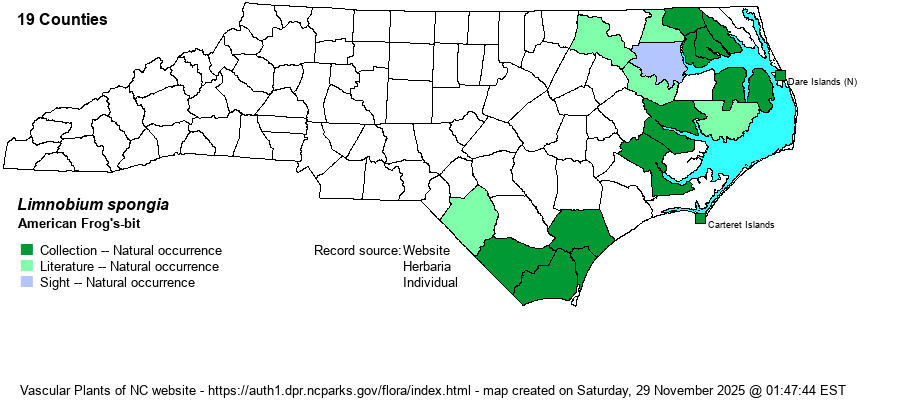| Author | (Bosc) L.C. Richard ex Steudel | |
| Distribution | Present in the outer half of the Coastal Plain, inland to Halifax and Robeson counties. A few iNaturalist photo records into the eastern Piedmont are Research Grade, but need additional evaluation, as flowers are not visible.
This species has a two-part range along the Atlantic coast from DE south through FL and west to eastern TX; then northward up the Mississippi River Embayment to MO and southern IN. | |
| Abundance | Uncommon and somewhat local, still lacking specimen records for a handful of counties in the eastern third of the Coastal Plain. Oddly scarce for the abundance of available "pool/pond" habitats. | |
| Habitat | This is a species normally growing in very shallow water of pond margins, pools, blackwater streams, and swampy interdunes. It may grow in marshes, as well. |
| Phenology | Blooms from June to September, and fruits shortly after blooming. | |
| Identification | This is a quite small aquatic plant with distinctly rounded leaves. It has a rosette of leaves, with stalks normally 1 inch or less, and a round or kidney-shaped blade with a cordate base, only about 2 inches wide and long. The leaves tend to lie rather flat on the water or ground surface, but can be raised off the water in some situations. Male and female flowers grow on separate stalks, each about 2 inches above the water. The flowers have 3 petals, white, rounded, and have a spread of 3/4-inch, looking quite similar to a flower of an arrowhead (Sagittaria spp.). Each stalk contains several flowers, but only one blooms at a time. Note that several other non-related plants can look quite similar to this species if not seen in bloom -- a frequent situation! The two species of Nymphoides have rounded and floating leaves with strongly cordate bases. N. cordata typically has purple blotches on the leaf surface, and the leaf is larger and usually a bit longer than wide; in flower, it has 5 petals. N. aquatica has even larger leaves (often 3 inches or more wide and long), is unblotched on the leaves, but also has 5 white petals; it has purple on the underside of the leaves and is strongly veined there, in case you feel stumped on the identification. Normally, the very small size of Limnobium -- about the size of a baseball when looking down on an individual plant, should suffice. At times it can be seen by looking down from a bridge over standing water in a swamp opening. | |
| Taxonomic Comments | None
| |
| Other Common Name(s) | American Spongeplant. Often written without the "American", such as Frog's-bit and Spongeplant. | |
| State Rank | S2S3 | |
| Global Rank | G4 | |
| State Status | | |
| US Status | | |
| USACE-agcp | OBL link |
| USACE-emp | OBL link |

